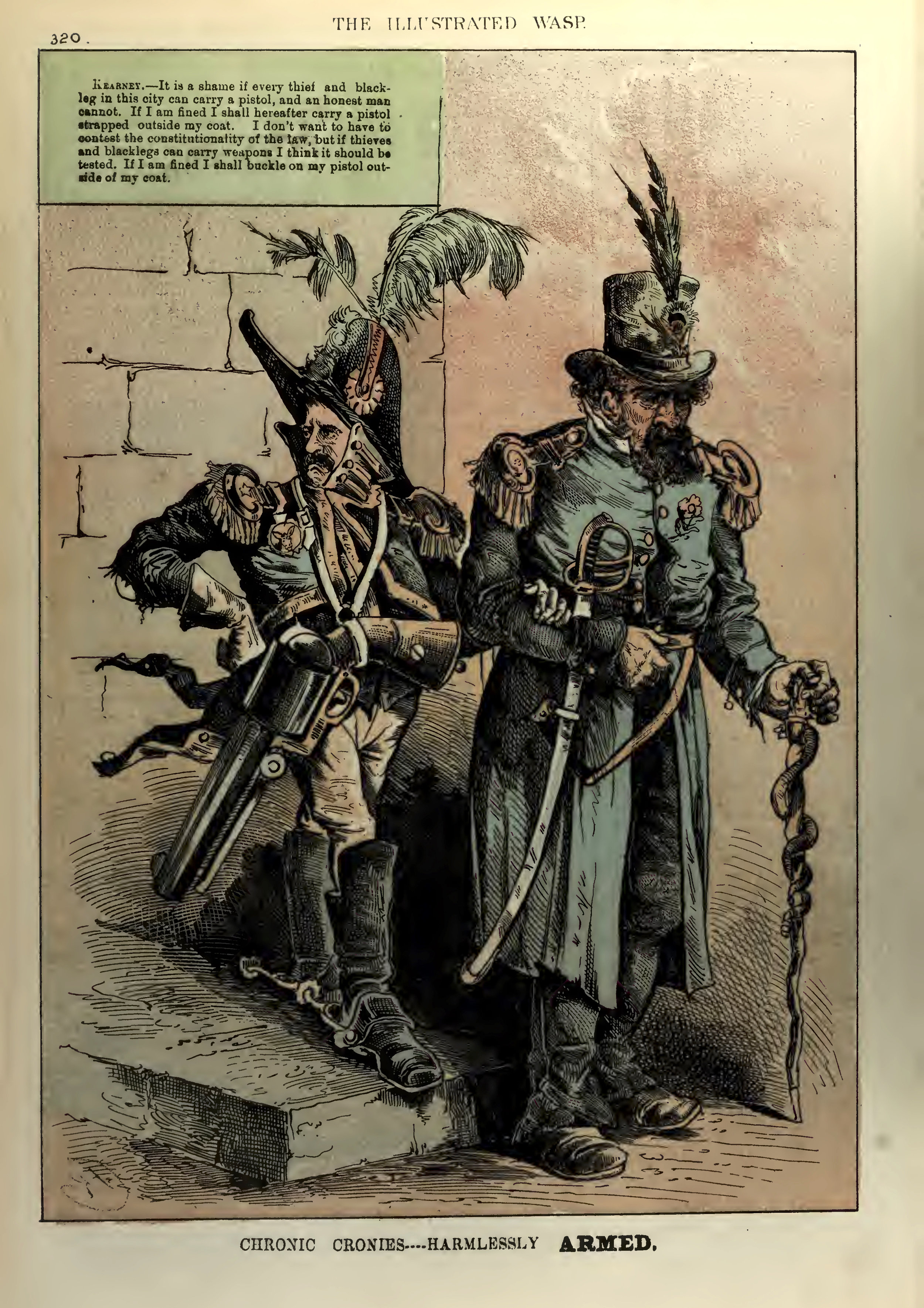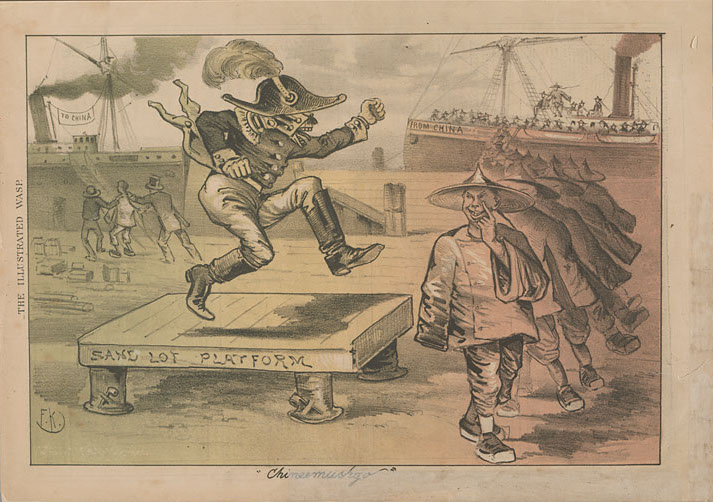Emperor Norton & Denis Kearney, Together in 1879 — On the Back Cover of The San Francisco Illustrated Wasp
FROM TIME TO TIME, our friend Woody LaBounty (of the Western Neighborhoods Project) passes along a few Emperor Norton-related items that he’s stumbled across in the course of his own research travels.
As often as not, we already have encountered these items. But, the wonderful find below, which appeared in our inbox a couple of weeks ago, is one we might well have missed — not least, because the absence of “Emperor Norton” or “Norton I” in the text of the item conspires to keep the item hidden, unless it is referenced in a secondary source.
Click the image for a greatly expandable view.
“Chronic Cronies — Harmlessly Armed,” cartoon by George Frederick Keller (1846–1927). The San Francisco Illustrated Wasp, vol. 4, no. 175, 6 December 1879, p.320. Source: Internet Archive.
[TITLE]
CHRONIC CRONIES — HARMLESSLY ARMED.
[CAPTION]
KEARNEY. — It is a shame if every thief and blackleg in this city can carry a pistol, and an honest man cannot. If I am fined, I shall hereafter carry a pistol strapped outside my coat. I don’t want to have to contest the constitutionality of the law, but if thieves and blacklegs can carry weapons I think it should be tested. If I am fined I shall buckle on my pistol outside of my coat.
This full-page cartoon appeared as the back cover of the 6 December 1879 issue of the San Francisco Illustrated Wasp. The cartoon is by George Frederick Keller (1846–1927), who was the sole cartoonist for the Wasp from the magazine’s launch in 1876 until 1883.
Pictured are two figures, arm in arm — on the right, Emperor Norton; on the left, the fear-mongering, violence-inciting anti-Chinese demagogue, Denis Kearney.
The Wasp was an unabashedly anti-Chinese publication; and, while working for the magazine, George Keller produced some the country’s most vitriolic anti-Chinese cartoons. But, the Wasp sought to distance itself from Kearney — and it mostly is Kearney who is being lampooned here.
The first clue: The fact that Denis Kearney is paired with — of all people — the Emperor Norton, whose quiet dignity stands in sharp relief to Kearney’s preening foppishness. Both men had taken positions on “the Chinese question.” By late 1879, Emperor Norton was well-known as a defender of the Chinese. Indeed, a year-and-a-half earlier, in April 1878, the Emperor — in an incident that was widely covered in the local papers — had appeared at one of Kearney’s notorious sand-lot rallies and had confronted Kearney directly, telling him, his associates and the assembled crowd to disperse and go home.
Kearney, for his part, still was making plenty of noise in late 1879. But, over the intervening months since his confrontation with the Emperor, Kearney had seen his influence as an anti-Chinese crusader fade.
In imitation of the Emperor’s sword, Kearney is shown wearing a literal strap-on of a revolver — anticipating the modern joke that the man who drives the biggest, fastest car or truck is compensating for his insecurity about his small phallus.
In further imitation of the Emperor, Kearney has donned a military coat with epaulettes and is wearing a hat and feather that is even larger than the Emperor’s.
For all this — indeed, even though Kearney is a step above the Emperor, who was not an especially tall man — Emperor Norton still is shown as the taller, larger figure.
The man of greater stature, physically — and morally.
:: :: ::
A BELATED FOOTNOTE — afternoon of 21 August 2019
It turns out that George Frederick Keller’s depiction of Denis Kearney here reflects themes that Keller had started developing at least a year and a half earlier.
It was when Kearney began styling himself as “Lieutenant General” of the Workingman’s Party of California and the broader “Chinese Must Go!” project that Keller began dressing Kearney in a military coat, epaulettes and bicorn hat, as in this Keller cartoon that appeared in the Wasp on 26 July 1879:
“Chineemushgo,” cartoon by George Frederick Keller (1846–1927). The San Francisco Illustrated Wasp , 26 July 1879. Source: Virtual Museum of Early and Native California.
Notice that Kearney’s mouth appears donkey-like. That is shown to more explicit effect in this Keller cartoon, which had appeared in the Wasp of 11 May 1878:
“The Chinese Must Go! But, Who Keeps Them?” Cartoon by George Frederick Keller (1846–1927). The San Francisco Illustrated Wasp , 11 May 1878. Source: Erratic Phenomena.
The central figure trades on the donkey as the symbol of the Democratic Party — where Kearney found support. (The editorial cartoonist, Thomas Nast, had reappropriated and popularized the long-forgotten Democratic donkey, starting in 1870.)
But Keller and the Wasp also were sending the more basic message that Denis Kearney was a braying jackass. “Kearney” is dressed here in a military coat and bicorn. And, lest there be any doubt as to who the ass is, the initials “DK” are placed next to his left collar.
Careful observers will have noted that, in the cartoon featured in the main article above, Keller gives Kearney a badge to mirror the Emperor’s bouttoniere. Yep — its a donkey.
Almost certainly, Denis Kearney was influential in securing the passage of the Chinese Exclusion Act of 1882.
But, by 1882, Kearney’s moment was past, and the Wasp was ready to write his political obituary — which it did, in part, with the following Keller cartoon, published on 13 January of that year.
The cartoon shows Kearney — at rear left — as a donkey skeleton. A sword has run the donkey through. Kearney’s bicorn hangs on the hilt. Below the bicorn, a sign: “KILLED BY THE WASP.”
“Siesta,” cartoon by George Frederick Keller (1846–1927). The San Francisco Illustrated Wasp , 13 January 1882. Collection of the California State Library. Source: Internet Archive.
For further reading, see Nicholas Sean Hall’s “WASP: Bipartisan Consensus and the Rise of the Workingmen's Party of California,” at Found SF. This is excerpted from Hall’s 2013 essay, “The Wasp's ‘Troublesome Children’: Culture, Satire, and the Anti-Chinese Movement in the American West,” originally published in California History, vol. 90, no. 2 (2013).
See also “The Chinese Must Go! But, Who Keeps Them? 1878” at the website Illustrating Chinese Exclusion.
:: :: ::
For an archive of all of the Trust’s blog posts and a complete listing of search tags, please click here.
Search our blog...




